
Triangle iron: The crisp sound of percussion instruments
The Triangle is a metal percussion instrument widely used in symphony orchestras, with a crisp, penetrating sound, but no fixed pitch. For the performer, if you want to play different timbre, you need to find different sounds in each part of the triangle to achieve good results. The history of the triangle can be traced back to 3000 BC, and it is evolved from the ancient Egyptian pharaohs 'sacrificial fork bell (Sistrum) ([1]). Before and after the 18th century, the shape of triangle iron was mostly isosceles triangle or trapezoid accompanied by a buckle, and the size was larger. During the Romantic period, triangles began to appear more and more in symphonies, and eventually removed the buckle and slowly developed into the equilateral triangle of today ([2]). We can also see it in the new music works of the 20th century, and now as a commonly known percussion instrument and commonly used in bands, the development of the triangle has a winding history.
Many musicians or music lovers have traced the history of the triangle back to 3000 BC, As Mark Berry wrote in his article "From angels to orchestra(part I):an iconographic history of the triangle through the 19th century. The article explains in detail how the triangle evolved from the fork bell used by the pharaohs in ancient Egypt to the widespread use of the symphony orchestra in the 19th Century.
Another example is the book "Drum circle - A guide to word percussion." which shows us the playing techniques of triangle iron, from how to hold the instrument during playing to different playing methods of triangle iron in different styles and types of music works.
The playing method of triangle iron is actually not complicated, it is one of the instruments that can be quickly mastered by all percussion instruments, although it looks simple and easy to use, but want to play a crisp and bright timbre and the correct time difference, it is not an easy task. The performance of the triangle must rely on metal percussion sticks to sound, and the sound produced by different materials and lengths of percussion sticks is also different, just as the triangular iron selected for different musical works of different styles and types is also varied in performance methods.
First, the introduction of triangle iron
(1) Material
Triangle iron is a percussion instrument made of a round steel bar bent into a triangle, and there is a notch at the junction of its two ends, which is a metal percussion instrument. In a large symphony orchestra, we usually hear triangle iron through the orchestra to stand out, and give the music a special color, usually played with a small metal rod (sometimes with wooden drum sticks) sound, its tone is sharp, crisp, strong penetration ([3]) (see Figure 1).
Figure 1 Triangle iron
Throughout history, triangles have evolved from solid iron to steel rods bent into an isosceles triangle or trapezoid shape (see Figure 2). Today, the triangular iron of the closed isosceles triangle has been abandoned and started to be made of steel or brass ([2]).
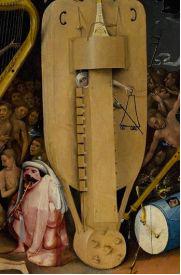
Figure 2 Trapezoidal triangle iron in 18th century oil painting
(2) Size
Most of the dimensions of the triangle are between 4 and 10 inches, while 6 to 10 inches is the size commonly used in the symphony orchestra, the larger size of the triangle is suitable for playing romantic period works, because its size and texture determine its pitch and timbre. Since there is no standard size regulation, it is the responsibility of the percussionist to temporarily select triangle iron of different sizes and pitches ([4]) according to the needs of the musical work and the requirements of the conductor (see Figure 3). The famous American percussionist Alan Abel, named after his series of symphonies with triangle iron, there are various sizes and thickness used to play different styles of music works. For example, the 6-inch Wagner/Mahler triangle (see Figure 4) is full of sound, rich and penetrating, and plays with bright colors. The small 4-inch triangle (see Figure 5) is suitable for playing the third movement of Brahms' Symphony No. 4. The very weak part C needs the clean, clear and gentle sound of the triangle, and the original score is marked "p". However, in the actual performance, the intensity is often "pp" (see Figure 6), and the timbre of the trumpet 4-inch triangle is very suitable for playing this musical work ([5]).
Figure 3 Triangle iron of various sizes
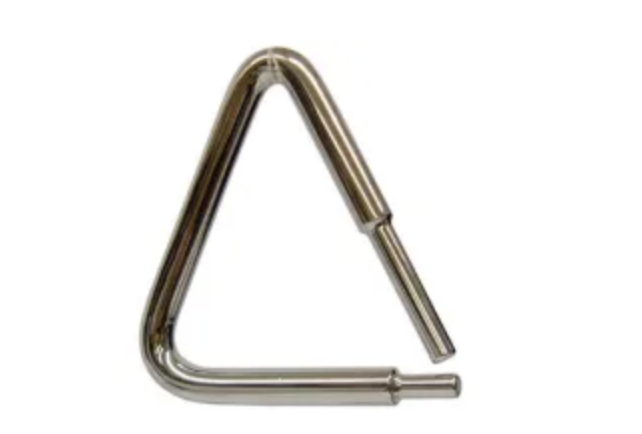
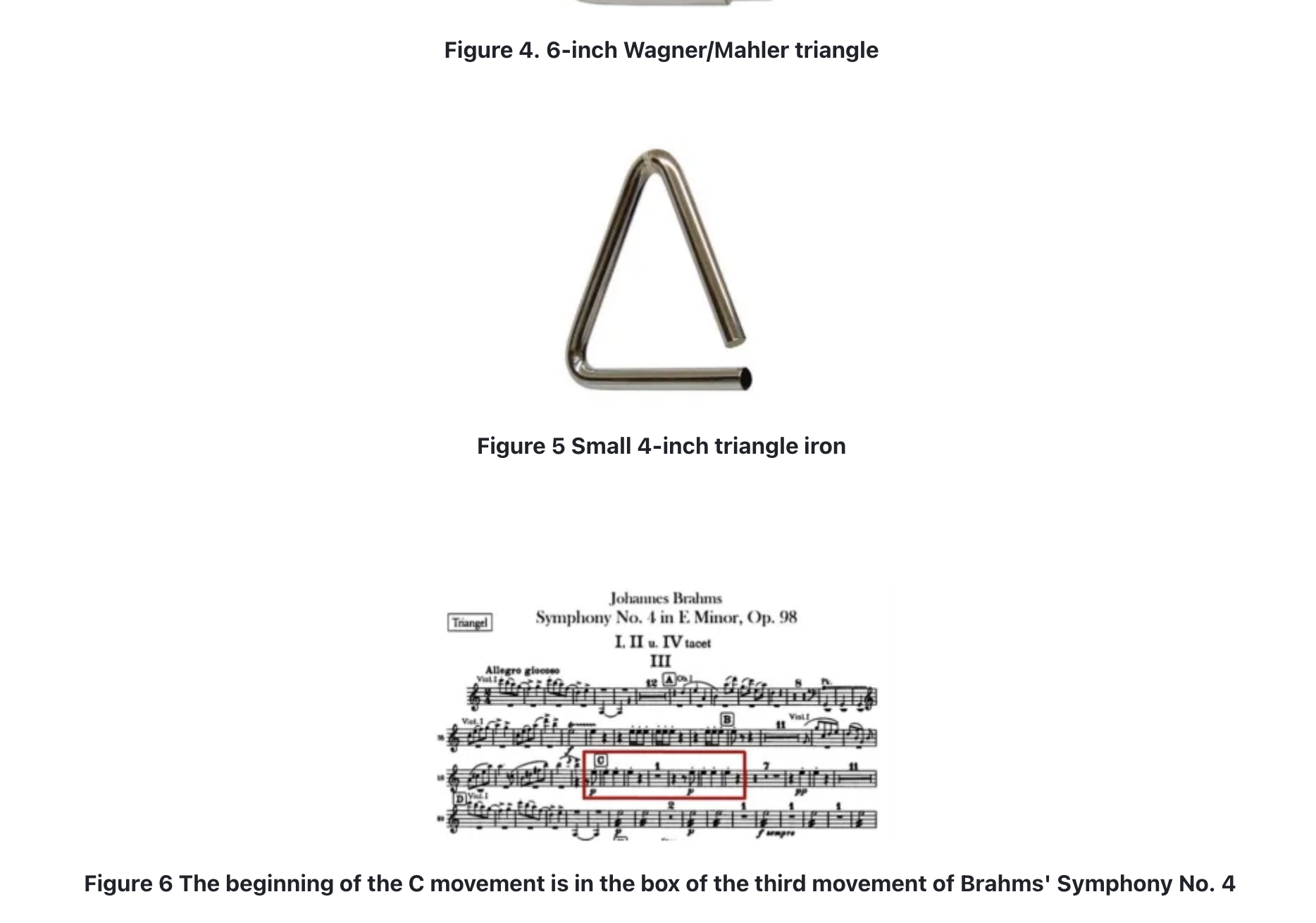
Two, the history of triangle iron
(1) The historical origin of the triangle iron
As early as 3000 BC, there was a prototype of the triangle iron, scholars believe that the earliest form of the triangle iron is from an ancient Egyptian musical instrument - the fork bell (Sistrum). The forked bell was the first percussion instrument used by the ancient Egyptians, consisting of a handle and a U-shaped metal frame, on which two to four rows of beams were suspended from which metal discs made sound when shaken, operating on the same principle as Chinese rattles, which were usually made of clay, wood or metal ([2]). Percussion instruments such as fork bells provided a rhythmic accompaniment to ancient Egyptian music, especially at religious ceremonies and festivals ([6]).
The fork bell was a sacred instrument in ancient Egypt, perhaps derived from the worship of the gods of the ancient Egyptians ([7]), so it was often used in dance and religious ceremonies, especially the worship of the goddess Hathor, whose head was decorated on the handle of the fork bell, symbolizing love and devotion ([8]).
The Roman invasion of Egypt in 30 BC helped spread the use of the fork bell, giving it more Greco-Roman symbolism ([2]) (see figures 7, 8).
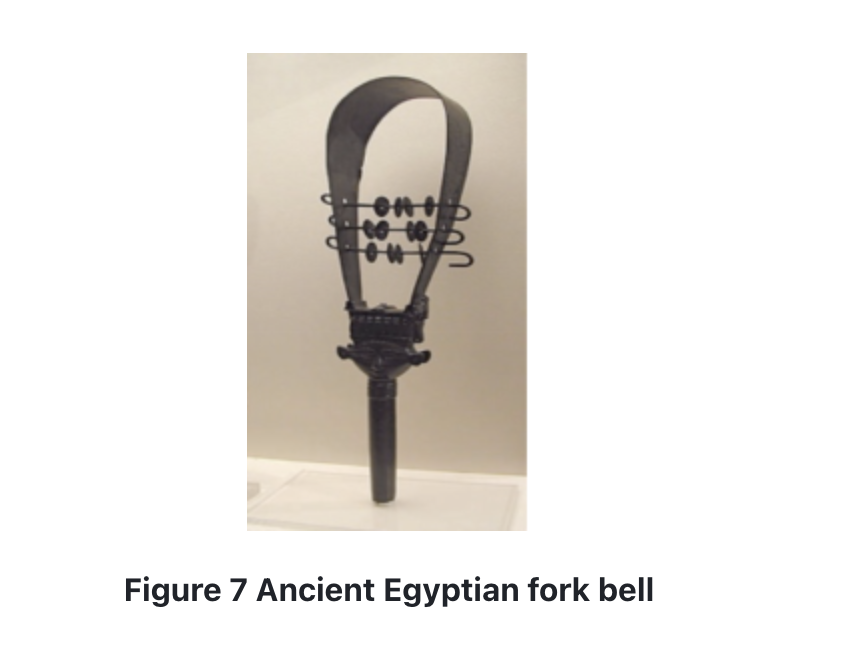
Some scholars have pointed out that the triangular iron is directly developed from the fork bell, but did not elaborate the historical relationship between the fork bell and the triangle iron. If the triangle is indeed a direct development of the fork bell during the Pharaonic period and the Renaissance, we can hope to find a connection between the fork bell and the modern triangle, and thus find out how it evolved. However, scholars have not been able to find evidence to support this view ([2]). The religious background of 15th century Europe can indeed help scholars to find the connection between the triangle and the fork bell, because the fork bell has always been associated with religious ceremonies throughout history. In appearance, the only similarity between the fork bell and the triangle is a horizontal metal beam with a buckle between the two instruments. In the historical process of the evolution of the fork bell into the triangle iron, it must lose its appearance rooted in non-Christian (the worship of Egyptian gods), including the handle, the physical size, and the way it is held, the sound and the tapping. The triangular iron and the fork bell appear in several 17th-century Musical Instruments, and there are clear differences in their appearance ([1]). This fact further proves that the triangular iron is not directly developed from the fork bell, and there is an independent development process between the two. In this way, it seems that the triangle is only a "cousin" of a kinsman of the fork Bell, rather than a direct "descendant" ([9]).
In Mark Berry's article "From angels to orchestra(part I):an iconographic history of the triangle through the 19th Century." It is explained that scholars have found triangle iron in some manuscripts and images of the 10th century, in which the triangle iron appears in the form of no buckle (see Figure 9). Morris Goldenberg, in his book Modren School For Snare Drum, states that "the triangle was first recorded by notation in the 15th century" ([10]).

In the 14th century, triangles began to appear in European portraits, most commonly in Christian churches, on frescoes, ceiling vaults, statues, and church stained glass. With the appearance of the triangle in churches representing Christ, people think that this is a symbol of Christian instruments, because the triangle is also used to serve religious music. Because of its simplicity and loud sound, it soon became popular in both secular and folk music. Triangular iron became popular in the 14th century, and as we can see from religious images and sculptures of the 14th century, many of these triangular iron had clasping Rings on horizontal rods, which were called "Jingling Rings" because they made a "jingling" sound when they were shaken. And the triangle was often played by the angels or "MUSES" of the Christian gods. Triangular iron without a buckle also appeared as early as the 15th century, but the shape was slightly different from the modern triangular iron, mainly trapezoidal and triangular shapes ([1]) (see Figure 10).
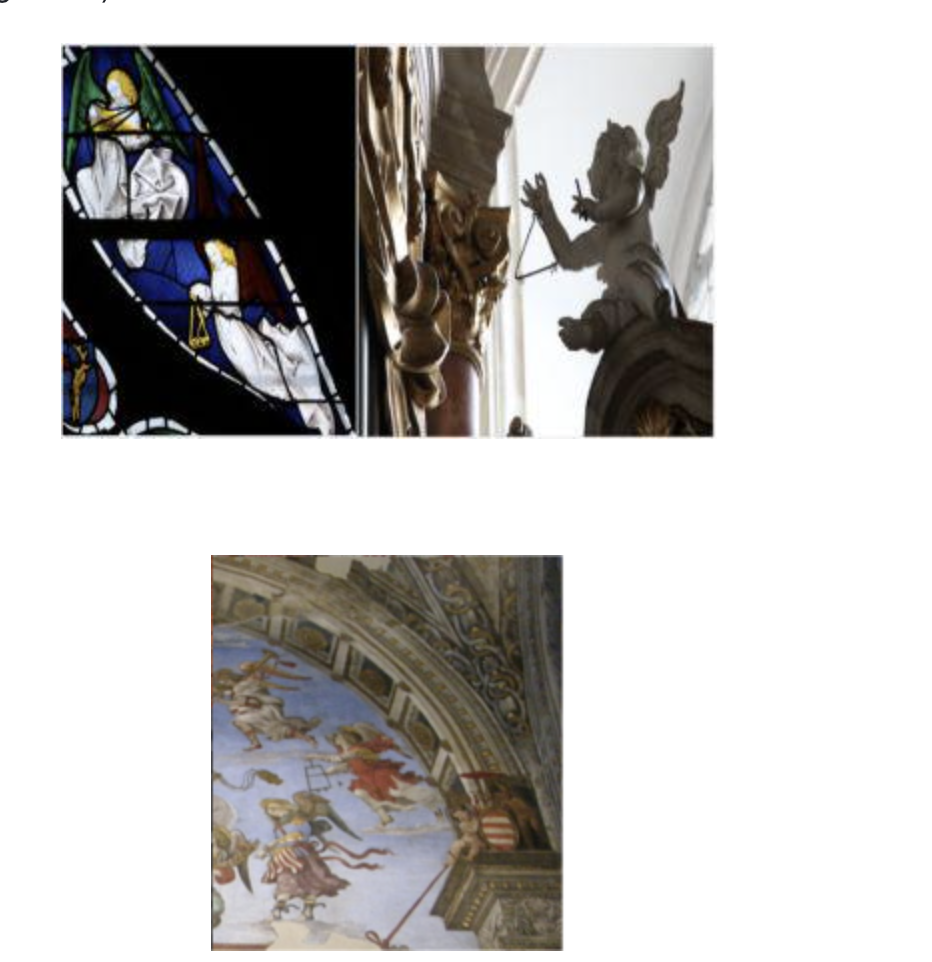
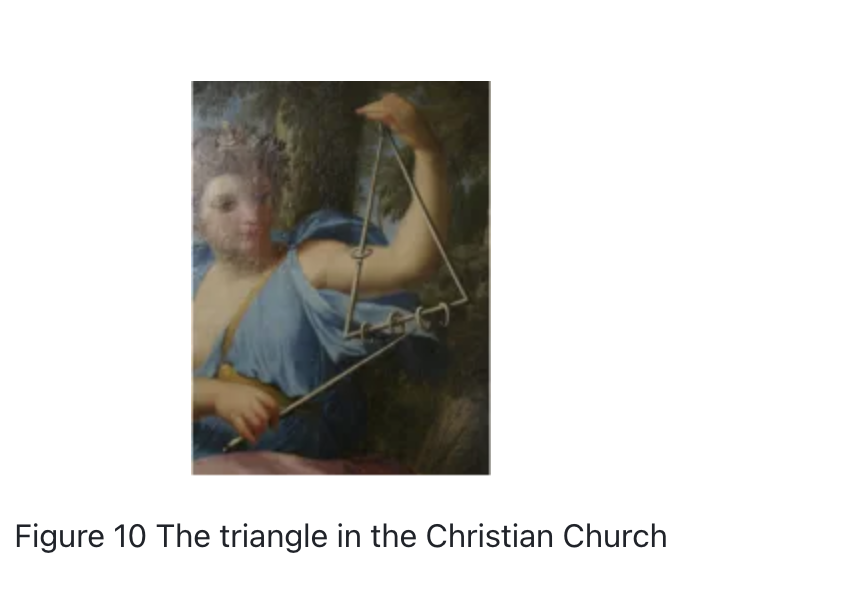
From the images of that time, we can see that the dimensions of the triangle were much larger than today, about 8 to 12 inches, and some even reached 16 inches, and the metal percussion rods were much longer ([2]). We can also see from the image that there was a round iron ring or wire at the top of the triangle, and a handle for holding the instrument ([1]).
(二)Brief description of the development from 18th to 20th century
Triangle iron gradually became widely used from the 18th century, and its timbre brought new associations and innovations to music creation, which began with the Praetorian Guard Corps. The Praetorian Guard is Turkey's elite infantry unit that defended the country for nearly 500 years during the Turkish Ottoman Empire. Turkish Praetorian music is considered to be the oldest marching military music in the world, and their bands are called "Mehter" ([11]). The army band consists of several groups, and the instruments commonly used in each group include: drum, double-faced drum, recorder, trumpet, and cymbals. In an era of poor communication, this well-trained band was able to communicate with the various armies and inspire and intimidate the enemy ([12]) (Figures 11, 12).
Figure 11 Turkish military music
Figure 12 Musical Instruments used in Turkish military music
During this period, Turkish military music developed rapidly and had a significant impact in Europe and the world. In the 17th and 18th centuries, this influence created a "Turquerie" in continental Europe, a form of exoticism that partly reflected the continent's fascination with Turkish art, music, and culture. Growing trade and diplomatic relations between European countries and the Ottoman Empire also contributed significantly to this trend ([13]). In the works of many famous composers of the time, such as Haydn's Army Symphony, Mozart's opera Escape from the Harem ([14]), and Beethoven's Ninth Symphony, we can feel the influence of Turkish music in their creation ([15]).
However, the triangle is not a common instrument in Turkish military music, because the triangle's historical background is associated with Christianity, while Turkey is Islamic ([16]). Morris Goldenberg also notes in his book that for three centuries, the triangle would not be used in formal musical Settings ([10]). In the 17th century, the "Turkish craze" began in all European countries, and the "Mechtl" music style was incorporated into their own military music, and soon military bands across Europe began to use "Turkish" percussion instruments, especially bass drums and cymbals ([17]). However, military composers found the original Turkish music to be rigid and unpleasant, and soon they added their own style to the music, including the use of triangle iron. This is why the triangle is sometimes included as part of the military instrument, although not of true Turkish origin, the triangle is indeed found in European bands with a "Turkish style" and "Praetorian-style" ([18]).
With the addition of the triangle, military music composers began to use the triangle as a sound imitation of Mechtel music, along with the drum, cymbals, and timpani to control the rhythm of the music. In early opera and orchestral music, the triangle was not marked, but when it was, it was usually repeated with eighth and sixteenth notes, reflecting the rhythmic limitations of the triangle at the time ([19]).
By the 1720s, the Romantic period of music began, and composers began to study the continuity of the triangle. Today, this date can be used as a reference point for considering whether to use a triangle with a buckle in modern performances ([15]). In general, the triangle with the buckle is historically and musically applicable to all European and American music before the 1720s, including orchestral, symphonic, operatic, sacred, secular, and military music ([16]).
In the 19th century, Europe's "Turk fever" waned. In art, literature and music it was replaced by a strong sense of romanticism. Composers began to write symphonic works on a large scale, and performing these large works required an orchestra to match them, and to expand the different timbre for these large works. In search of these new timbres, composers of the Romantic period began to explore the clean, bright sound of the triangle, which could only be expressed if the triangle had no clasp ([18]).
At this point, the buckle that had been associated with the triangle for five centuries was removed and no longer used. In the Romantic period, we can find the triangle iron in Liszt's Piano Concerto in E-flat Major (FIG. 13), Brahms' Symphony No. 4 ([5]), Mahler's Symphony No. 6 ([20]), Tchaikovsky's 1812 Overture ([5]), and many other composers.

Figure 13. Triangle Iron score of Liszt's Piano Concerto in E Flat Major
(3) The application of new works in the 20th and 21st century
By the 20th century, in addition to performing the familiar classical Music, Triangle was frequently used in American Cajun Music (①), Brazilian music, and Latin music ([21]). In particular, the use and performance of the triangle in Brazilian music is in stark contrast to classical music. In terms of timbre, in the symphonic works, the composer pursues how the beautiful and finishing timbre of the triangle iron can coordinate and unify with other instruments in the band; However, due to the attributes of dance in Brazilian music, triangle iron is mostly used to reflect rhythm, so it must produce a short and rhythmic sound ([22]). In Brazilian music, because the triangle needs to always beat the Hi-Hat(②) rhythm, the player does not need a string to hang the instrument when playing, but directly hold the open side of the triangle with the hand, and use the percussion stick in the other hand to vertically hit the opposite side of the hand. Open and stop sounds are achieved by releasing or grasping the index, ring, and pinky fingers of the triangle iron (Figure 14). The triangular iron used in the performance is also selected to be 10 to 12 inches, and the metal percussion rod played is also thicker ([5]).

In northeastern Brazil, Forro, a local folk dance music, is also played using larger triangles and metal percussion sticks to represent a continuous and intense rhythm ([6]).
In the popularity of new music works today, the triangle is not only a color instrument in the symphony orchestra, its use has long gone beyond its own scope. In the musical piece Three Angels, three players hold three different sizes of triangle, a total of nine triangle to complete the performance ([23]) (Figure 15).
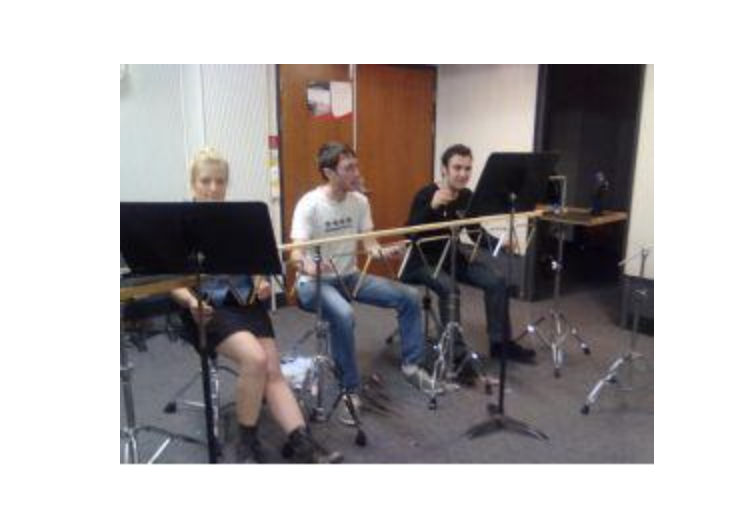
Three, playing methods and skills
(1) Performance methods before the 20th century
Before the 1720s, the main form of triangular iron was a closed equilateral triangle with a buckle, and the metal rod was much longer than today's, producing only a short, dull sound ([2]). By the beginning of the Romantic period in the 1820s, composers began to explore new ways of playing and timbre for the creation of the triangle, and the buckle that had been associated with the triangle was finally removed. Later, the triangle gradually appeared in the symphonic works of Mozart, Haydn, Beethoven and other famous composers, and today, the most common occasions for people to use the triangle are in symphony orchestras ([22]).
From the 18th century to the present, the traditional method of playing triangle iron is to hang a rope on their instruments, and this rope players often choose cheap and strong fishing line, and put the rope hung with triangle iron on the index finger of one hand, the middle finger, ring finger and little finger are used to hold the triangle iron to achieve the effect of stopping the sound, and the other hand is struck with a metal percussion rod ([24]).
(2) Modern playing methods
Nowadays, with the development of The Times, musical works are also constantly innovated, such as the triangle musical work "Three Angels" introduced above. In this work, the traditional triangle performance method is no longer applicable, because three people are needed to play nine triangles, so the triangle iron frame perfectly solves this problem. In another piece of music, "Meets," a player plays multiple triangles at the same time, and a triangle is necessary ([5])
It can be said that the triangle iron frame is a product of The Times, a professional triangle iron frame, can let the performer more freely play the work, but also for many composers to provide creative and imaginative space. Now the professional triangle iron frame also began to be sold together with the triangle iron, and the shape is very diverse.
New musical works in the new century can be said to bring unlimited creative space to music, and also bring business opportunities to instrument manufacturers. In order to better adapt to a variety of different musical styles, manufacturers have created triangle iron specially used to play new musical works, such as Kaijin Triangle iron specially used to play American "Kaijin music" ([25]).
There is also the "LP One-Handed Shaker Triangle" dedicated to playing Latin music.
It can be seen that the shape of "LP one-handed Shaker triangle" is completely different from the traditional triangle, and the way of playing is also easier. As long as the middle finger and index finger of one hand hold the concave card slot of the instrument, and then shake the wrist back and forth, the metal ball in the middle of the card slot can make the "kicking" sound needed for Latin music through the back and forth impact.
In addition, composers have been working tirelessly to explore the possible timbre of the triangle, such as Bartok's Sonata for Two Pianos and Percussion, in which the triangle is played using a mallet. Some pieces are even played with triangles laid down on tables ([5]).
In order to reproduce the timbre of the triangle in the 17th and 18th centuries, music researchers and manufacturers have created a triangle with a buckle through the images retained at that time, which allows us today to listen to the timbre of the triangle with a buckle centuries ago
(3) Triangle playing skills
The traditional method of playing the triangle iron, as described above, is to play the instrument by hanging on a string, and the way the triangle is hung is very important for the quality of the sound produced. Since the triangle is a highly resonant instrument and must be able to vibrate freely, a clamp suitable for the triangle iron and a strong and durable suspension rope are essential. Too thick or too thin rope will make the triangle sound bad, the best material is cheap and durable fishing line. But in general, with the line, there should also be a clamp or a horizontal wooden handle, which determines whether the triangle iron can produce a good sound. The welding clamps sold on the market are standard clamps of just the right size, and these metal clamps have rubber covers at the front and back of the clamps to prevent the clamps from making noise on the metal frame and from scratching your fingers ([26]) (see Figure 21).

The fishing line connecting the clip and the triangle iron plays a key role, there are generally two, one is the main support line, and the other is the protection line, the protection line is to prevent the support line from breaking and destroying the performance during the performance, so the protection line is more important than the support line. The distance between the fishing line connecting the clip and the triangle should not be too long or too short. If it is too long, the sound will be too loud because it is impossible to use the finger to stop the sound. If it is too short, the space between the rope and the triangle will be too small, and the finger stop area will be too large, which will make the sound dull. This distance allows for better control of the timbre ([2]) (see Figure 22).
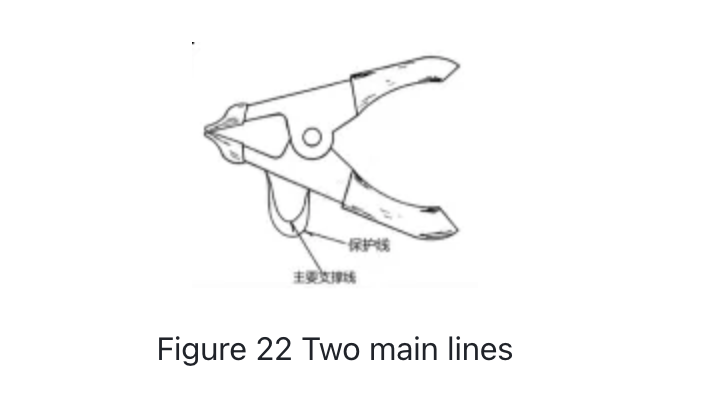
The purpose of the clamp is to prevent the finger holding the triangle from touching the triangle while playing and destroying the vibration sound. The basic holding method of the triangle iron with clamps is like this: With the fingers of one hand open, the thumb, middle, ring, and pinky hold the clip under the clip, and the index finger above the clip to hold the clip in place to ensure that it does not drop or slide, raise the arm holding the instrument to shoulder level, so that the triangle is in direct sight, and hold the metal percussion stick in the other hand ([4]) (see Figure 23).
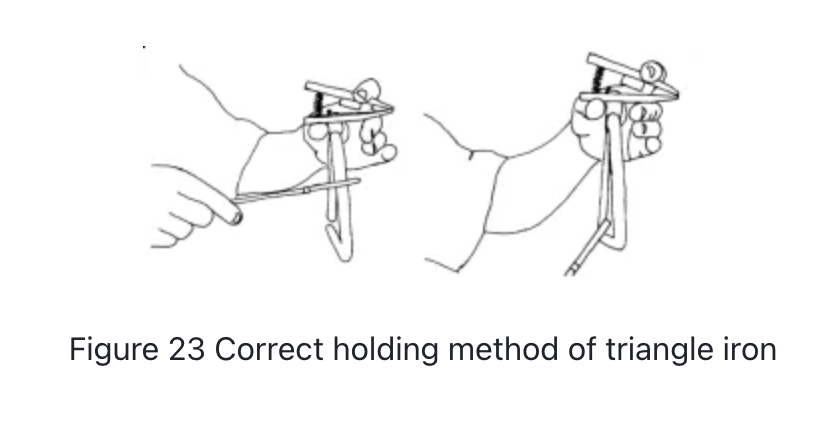
The advantage of this is that in addition to ensuring the complete free vibration of the triangle, it also allows us to immediately make a stop in response to the command of the gesture. The stop of the triangle requires the hand holding the instrument to hold the instrument itself with its fingers to prevent the triangle from vibrating freely, which is a short and dry sound. The open tone, which allows the hand holding the percussion stick to strike the inside of the instrument, allows the triangle to vibrate freely, and this tone is extended and crisp ([3]).
To complete the rolling of the triangle, one hand should hold the clamps on which the triangle is suspended, and the index finger and thumb of the other hand should hold the percussion stick, the index finger should be bent and relaxed, and the wrist should also be relaxed as the triangle is struck up and down. This movement is played sideways in the triangle, striking down on the horizontal metal beam and up on the metal column forming an Angle to the horizontal beam. This roll is usually played with eighth or sixteenth notes ([27]).
So if you want to get a good sound on the triangle, you have to find the golden section of the triangle, which is on the right side of the lower beam, where the sound is completely vibrating, and when the triangle vibrates, the whole arm will vibrate with it, and only hit the front of the rod, the sound produced in this position is transparent, clean and bright. The "ding" sound produced can travel a long distance ([5]).
In some works to achieve the effect of rapid percussion, the triangle can be clamped to the support frame, so as to perform two-handed performance ([23]).
Another percussive method is to strike a metal post at an oblique Angle on the outside of a triangle iron, which is commonly played in the "Bossa Nova(③)" style of music characterized by medium-speed syncopation. No matter what style of music, the choice of triangle iron and percussion rod is very important, different sizes, materials, types of percussion rod to play the sound is not the same. Professional percussionists are usually equipped with several percussion sticks of different thickness, length, and material ([28]) (see Figure 24).
Figure 24 Triangle iron equipment of professional percussion players
The full name of the triangle's Open Tone is "open Tone" and the full name of the stop tone is "Muffle Tone", which is often shortened to "O" and "+" in sheet music ([6]). The way the triangle is played in The Lion King is the way Brazilian samba music is played, with one hand holding the opening of the triangle and the other hand holding the percussion stick (see Figure 25).
Figure 25 Music "The Lion King" triangle iron score
If you want to play this instrument well, you must do the following ([26]) : 1. When you play, focus more on timbre than volume. 2. Although there are various sizes of triangle iron suitable for symphonies, the most common size is 6 inches, and the important thing is the timbre. 3. Find the best tone point for each triangle. 4. Depending on the situation, it is decided to use different sizes and thicknesses of triangle iron or different sizes and thicknesses of percussion rods. 5. Professional percussionists are equipped with a variety of percussion sticks of different sizes and weights as part of their equipment. 6. Do not break the instrument, protect the timbre tone of the triangle iron, extend its service life, and put it in the protective bag when not in use.
4. Conclusion
The triangle has now become a common instrument in major symphony orchestras, percussion orchestras and bands. Throughout the history of the triangle, it has gone through many changes from an ancient Egyptian pharaoh's sacrificial tool to today, and finally attracted people's attention in the long history of thousands of years of music. More in Liszt's "Ninth Symphony", Mahler's symphonic works, Ravel's suite "Daphne and Croet", the Russian "Five powerful group (④)" and other works, but also finally from an easy to ignore the instrument has become an indispensable "percussion family member". Although the triangle is relatively small compared with other Musical Instruments and is very easy to play in the eyes of ordinary people, it is not an easy task to grasp the playing skills and essence of the triangle. Therefore, in recent years, musicians represented by Alan Abel have emerged and focused on developing the triangle career. The percussist, educator and musical instrument maker He was the percussion chief of the Philadelphia Symphony Orchestra, one of the Big Five, taught at Temple University, and was inducted into the PAS Hall of Fame in 1998. His triangle iron has become his trademark, pure, clear sound color makes his triangle iron become one of the most popular products in the professional field.
Since the new century, more and more musical works of different styles and types have been emerging, and in order to better play these works, triangle iron is also constantly changing and developing, and there are even new instruments such as "3D triangle iron", "arc triangle iron", "double triangle iron", "LP single-hand Shaker triangle iron" and so on. These changes are the result of manufacturers and players constantly exploring and developing more plasticity of triangle iron to adapt to the needs of this rapid development era.
Notes:
Bossa Nova: Portuguese, is a fusion of Brazilian samba and American cool jazz "new style jazz".
The Russian "Five Powerful Group" refers to the composer society composed of Balakilev, Mussorgsky, Limsky Korsakov, Borodin, Guy and the art critic Stasov.
References:
[25]Wikipedia. Triangle
(musical instrument).
https://en.wikipedia.org/wiki/Triangle_(musical_instrument).2013/3/31.
[26]Cirone A J.Percussion repair and maintenance a performer’s technical manual[M].EL03285.
Printed in USA.Belwin Mills Publishing Corp.(ASCAP).1986:59.
[27]beebee. Why is the triangle player the most respected person in the symphony?
[DB/OL]. https://www.ishuo.cn/doc/znojjfqf.html.2016/09/02.
[28] Zhihu users. Why would a top band have a triangle player?
[DB/OL]. HTTP: / / https://www.zhihu.com/question/27450056.2015/01/07.
[29] Wen Jie. The playing technique of the Triangle Iron, an elf in percussion instruments [J]. Sound of the Yellow River, 2008, 22 :44.
[30] Lu Lijuan. The Enlightenment of "Triangle Iron" [J]. Music Education in primary and secondary schools. July 2014:20 pages.
Source of illustrations:
Figures 1, 3, 4, 5, 17, 18, 19, 21: Network sources
http://www.steveweissmusic.com/category/triangles
Figure 7, 8, 9, 10: From Mark Berry. "From angels to orchestra(part I):
an iconographic history of the triangle through the 19th Century."
Figures 11, 12: Network sources
https://www.douban.com/note/535422152/
Figure 13: From Morris Goldenberg. "Modren School For Snare Drum."
Photo 14: Taken by the author at the rehearsal hall of Zhaoqing College Wind Orchestra on April 13, 2017.
Photo 15:2009, Queensland College, Australia.
Photo 6, 16: Provided by Ms. Wang Yuyan.
Figure 2, 20: Network sources
http://www.livingsoundtriangles.com/
Figure 22: From Cirone A J. "Percussion repair and maintenance a performer's technical manual."
Figure 23: From Grover N.& Whaley G. "About the triangle."
Figure 24: Network sources
https://www.zhihu.com/question/29859671?sort=created
Figure 25: Network sources
https://www.zhihu.com/question/27126753